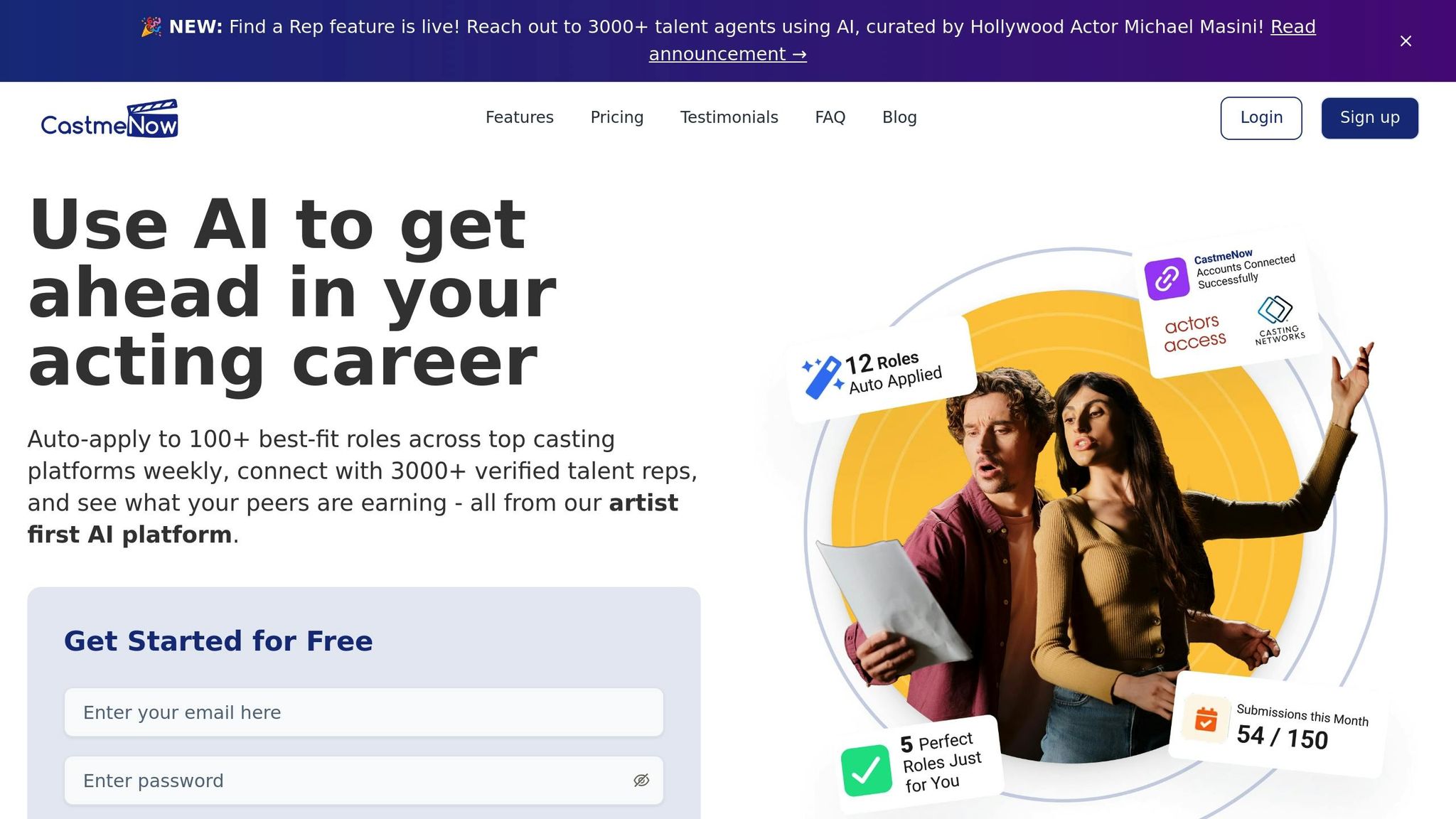Talent Demand Forecasting Explained
Explore how talent demand forecasting transforms casting decisions by analyzing audience preferences and industry trends.

Talent demand forecasting uses data to predict audience interest in entertainment professionals like actors, directors, and musicians. By replacing guesswork with measurable insights, this approach helps casting directors and talent managers make smarter decisions based on audience preferences, trends, and sentiment. Here's what you need to know:
- How it works: Platforms like Parrot Analytics analyze data from employment reports, casting platforms, and social media to identify trends and rank talent.
- Key benefits: Forecasting simplifies casting decisions, helps actors target skills in demand, and improves resource allocation.
- Modern tools: Automation platforms like CastmeNow streamline the casting process by matching actors to roles based on forecasting insights.
This data-driven method is reshaping the entertainment industry, making decisions more precise and aligned with what audiences want.
Key Data Sources for Talent Demand Forecasting
Talent demand forecasting draws on a wide range of data sources to identify trends and shifts in the entertainment industry. From traditional employment reports to social media analytics, these insights help map out the evolving landscape of talent needs. Let’s take a closer look at how these data streams come together.
Industry Employment Statistics
Reports from organizations like the Bureau of Labor Statistics provide a foundation for understanding job growth, seasonal patterns, and regional trends in entertainment sectors such as film, television, theater, and digital media. These reports highlight where opportunities are expanding and where they may be contracting.
Additionally, union data from groups like SAG-AFTRA and updates from state film commissions - such as Georgia's tax incentive programs - offer a closer look at shifts in talent supply and production activity. These insights are vital for spotting emerging hotspots and understanding how policy changes may impact the industry.
Casting Platform Analytics
Digital casting platforms add another layer of insight by tracking metrics like role postings, submission trends, and booking rates. These analytics help identify which character types are in demand and which demographics are being targeted.
For example, analyzing submission-to-booking ratios can reveal areas of market saturation versus roles with untapped opportunities. Geographic data, such as an increase in Atlanta-based postings or activity spikes during pilot season, also sheds light on regional and seasonal production trends.
Social Media and Engagement Metrics
Social media platforms like Instagram, TikTok, and Twitter now play a critical role in gauging an actor's marketability. Casting directors often evaluate an actor’s online presence, particularly for projects aimed at younger audiences who are highly engaged on these platforms.
Trending hashtags, viral TikTok challenges, and other social media movements can highlight the skills and themes currently in demand. For instance, a surge in posts related to environmental activism might signal a growing interest in stories or characters tied to that theme.
Additionally, sentiment analysis of social media conversations helps production teams understand audience preferences. By examining large volumes of posts, they can identify which stories and characters resonate most with viewers, enabling casting choices that align with current cultural trends.
Methods Used in Talent Demand Forecasting
In the entertainment world, predicting future casting needs and talent trends is no small feat. It relies on a mix of advanced techniques and traditional research methods to turn raw data into actionable insights. These forecasts not only guide casting decisions but also help actors plan their careers more effectively.
Predictive Analytics and Machine Learning
Machine learning algorithms have completely changed the game when it comes to analyzing casting trends and forecasting demand. These systems can process vast datasets, uncovering patterns that might go unnoticed by human analysts.
One key aspect is historical data analysis, which serves as a foundation for predicting future trends. Machine learning tools sift through casting records, production schedules, and booking patterns to identify recurring trends. For instance, they might reveal that certain character types are in higher demand during specific seasons or that certain demographics gain popularity after major cultural events.
Using pattern recognition technology, these systems can pinpoint hidden correlations. For example, they might find that increased investment in a specific genre by streaming platforms often leads to a surge in demand for particular acting skills a few months later. What’s more, these algorithms continuously learn from new data, refining their predictions as market conditions shift, ensuring forecasts stay relevant.
Real-time data processing is another critical feature. When a specific type of content goes viral on social media or streaming platforms, machine learning models can quickly integrate this information to update predictions. This ability to adapt on the fly makes these systems indispensable for aligning data with decision-making.
These tools also excel in demographic analysis, predicting demand for actors based on factors like background, age group, or specialized skills. This helps casting directors prepare for upcoming projects while giving actors a clearer picture of which skills might be worth developing.
Trend Analysis and Surveys
While machine learning provides a data-driven approach, qualitative methods add essential context. Historical casting data analysis is invaluable for spotting long-term trends and seasonal fluctuations in the industry.
Market surveys are another important tool. By gathering insights from casting directors, producers, and talent agents, these surveys shed light on anticipated project types, in-demand skills, and gaps in the current talent pool. They capture the human perspective on emerging trends and shifting audience preferences.
Through content analysis, forecasters dive into scripts, project announcements, and production plans to identify recurring themes and character types. This helps predict what roles will be in demand based on the kinds of stories being developed.
Focus group research with audiences provides direct insights into viewer preferences. These discussions reveal which characters and narratives resonate most with specific demographic groups, helping casting professionals align their choices with audience expectations.
Insights also come from industry conferences and panel discussions. When executives share their strategies or announce new initiatives, this information feeds directly into forecasting models. Similarly, trade publications help track industry announcements and production trends.
Lastly, regional analysis looks at how talent demand varies across different markets and production hubs. Understanding where opportunities are growing geographically helps both casting professionals and actors focus their efforts in the right places.
How Talent Demand Forecasting Affects Casting Opportunities
When talent demand forecasting is done right, it has a ripple effect across the entertainment industry. It helps casting directors make smarter choices, actors land roles that fit them better, and production companies allocate budgets more effectively. In short, it reshapes how casting decisions are made, distributed, and fulfilled.
Instead of being reactive, accurate forecasting turns casting into a proactive process. This shift benefits everyone involved, from studios to individual actors. By using data to predict demand for specific character types or demographics, casting agencies can prepare in advance. This preparation reduces delays, speeds up the casting process, and ensures stronger matches between roles and talent. It also supports better planning for resources across various aspects of casting.
Smarter Resource Allocation in Casting
With data-driven insights, casting teams can distribute their resources more effectively. For instance, budgets can be spent more wisely when teams know what talent will be in demand. Casting agencies can also refine their scouting efforts, focusing on actors who align with predicted trends instead of casting a wide, unfocused net.
Forecasting also makes seasonal planning more efficient. The entertainment industry has predictable cycles - holiday movies often cast in spring, summer blockbusters need decisions in fall, and streaming platforms plan releases around specific times of the year. Understanding these patterns allows casting teams to stay ahead of the curve.
Additionally, forecasting informs training and development programs. If the data shows a rising need for actors with specialized skills - like stunt work, fluency in certain languages, or unique physical traits - talent agencies can invest in training to prepare actors for these roles. This approach not only creates new opportunities for performers but also ensures agencies have the right talent available when productions need them.
Forecasting even enhances geographic resource planning. If data highlights increased production activity in certain areas, casting agencies can establish a stronger presence in those regions or partner with local talent representatives. This helps actors understand where opportunities are growing and allows agencies to connect with the right talent more efficiently.
Beyond operational improvements, forecasting drives more inclusive and representative casting decisions.
Promoting Diversity and Representation
Talent demand forecasting is a powerful tool for spotting representation gaps before they become widespread issues. By analyzing patterns in casting and audience preferences, forecasting can identify underrepresented demographics and predict where demand for diverse talent will grow.
With this information, production companies can take proactive steps toward diversity. Forecasting insights make it easier to align diversity efforts with audience demand, making these initiatives feel genuine and market-driven rather than forced.
Forecasting also helps expand the talent pool. As societal attitudes evolve and new communities gain visibility, forecasting can detect these shifts early and guide casting professionals toward actors who resonate with changing audience preferences.
Global and multicultural casting benefits significantly from demand forecasting. Streaming platforms cater to worldwide audiences, and forecasting can pinpoint which cultural backgrounds and languages will be most relevant for upcoming projects. This helps actors from diverse backgrounds understand which skills and experiences might make them stand out.
Age diversity also gets a boost. Forecasting can reveal trends in how different age groups are portrayed in media and predict where new opportunities might arise - whether for older actors, younger performers, or generational perspectives that resonate with specific audiences.
Efforts to improve accessibility and inclusion gain traction when forecasting identifies growing demand for actors with disabilities or other underrepresented characteristics. By building relationships with diverse talent before specific roles appear, casting directors can create a more inclusive industry.
Forecasting also supports regional representation by highlighting when productions will need actors who are familiar with particular geographic areas, dialects, or cultural traditions. This ensures that casting decisions reflect the diversity of the stories being told and gives actors from different regions a clearer sense of where their unique perspectives might be most valuable.
Using Automation with Tools Like CastmeNow

Talent demand forecasting helps casting professionals anticipate the types of actors needed for upcoming roles. But how do you bridge the gap between these forecasts and real-world casting opportunities? That’s where automation platforms like CastmeNow come in. By leveraging forecasting insights, they streamline the process of matching actors to roles, eliminating tedious manual searches and enabling quick, precise connections. CastmeNow serves as a prime example of how automation can transform the casting process.
How CastmeNow Simplifies Casting Automation
CastmeNow doesn’t aim to replace existing casting platforms like Casting Networks or Actors Access. Instead, it acts as a smart automation layer that integrates seamlessly with them. By connecting directly to your existing profiles, it automates the application process - saving you time while maximizing the value of the platforms you already use.
The platform’s intelligent algorithms match roles to your specific preferences and profile details, ensuring that only the most relevant opportunities are targeted. Better yet, CastmeNow operates 24/7, so it’s always working in the background, even when you’re not available. It monitors multiple casting networks at once and handles applications automatically, ensuring they’re formatted correctly and submitted without errors.
Why CastmeNow Stands Out
The benefits of CastmeNow go far beyond convenience. Here’s what it brings to the table:
- Time-Saving Automation: Forget spending hours scrolling through casting calls and filling out forms. CastmeNow takes care of the most time-consuming part of the job search, freeing you to focus on honing your craft - whether that’s audition prep, training, or performance work.
- Smart Role Matching: Its advanced filters analyze more than just basic criteria, helping you zero in on roles that genuinely align with your profile. This increases your chances of landing auditions and callbacks.
- Analytics and Career Insights: Get detailed feedback on your application patterns and success rates. These insights help you make smarter decisions about your career strategy.
- Secure and Centralized Management: Your personal information and casting profiles are kept safe, while the platform’s dashboard lets you manage multiple casting profiles in one place.
- Industry Updates: Stay informed with curated newsletters featuring casting calls, career tips, and updates on industry trends.
CastmeNow Pricing Plans: Options for Every Actor
CastmeNow offers two straightforward pricing plans, ensuring flexibility for actors at different stages of their careers. Both plans include a free 30-day trial with full access to all features.
| Plan | Price | Daily Applications | Key Features |
|---|---|---|---|
| Basic Plan | $3/month | Up to 10 roles | Standard casting network access, no long-term commitments, and budget-friendly pricing |
| Unlimited Plan | $8/month | Unlimited roles | Includes advanced analytics, enhanced role matching, and continuous application capabilities |
The Basic Plan is perfect for actors just starting out or those in smaller markets. It’s an affordable option for those who need fewer daily applications and are exploring automation for the first time.
The Unlimited Plan, on the other hand, is tailored for actors who want maximum exposure and detailed analytics. With unlimited applications and advanced tools, it’s ideal for those pursuing roles in larger markets or aiming to stay competitive in a fast-paced industry.
For agencies and acting schools, customized pricing options are available. With no hidden fees or long-term contracts, CastmeNow lets you adjust your subscription as your career evolves.
Conclusion
Talent demand forecasting is reshaping how actors and casting professionals navigate the entertainment industry. By analyzing market trends, audience preferences, and demographic changes, actors gain the tools to make smarter career decisions - whether it’s honing specific skills, targeting the right markets, or timing their roles strategically.
For casting directors and agencies, this data becomes a game-changer. It allows for smarter resource planning, making it easier to identify and connect with the right talent ahead of demand surges. The result? Better casting choices, broader representation, and productions that truly connect with audiences. Platforms like CastmeNow take it a step further by using these insights to automatically match actors with roles that align with market needs.
When forecasting is paired with automation, the benefits multiply. Tools like CastmeNow streamline the application process, allowing actors to focus on their craft while the platform handles the logistics. This blend of data-driven insights and automation sets the stage for a more efficient and opportunity-rich casting process.
FAQs
What is talent demand forecasting, and how does it help actors and entertainment professionals plan their careers?
Talent Demand Forecasting in Entertainment
Talent demand forecasting involves predicting future trends within the entertainment industry to identify which roles, skills, or genres are likely to gain traction. For actors and other entertainment professionals, it serves as a critical tool for shaping their career strategies.
By staying ahead of industry trends, actors can prioritize developing skills that align with upcoming opportunities. For instance, if a particular genre is expected to see a surge in demand, professionals can adjust their training to match that need. This forward-thinking approach allows them to remain competitive in an industry that’s constantly changing, enabling smarter decisions and better preparation for what lies ahead.
How do social media and engagement metrics influence talent demand forecasting?
The Role of Social Media and Engagement Metrics in Talent Demand Forecasting
Social media platforms like TikTok, Instagram, and Facebook aren't just places to share content - they're treasure troves of real-time data about audience preferences, trends, and behaviors. By tapping into these insights, casting professionals and platforms can better predict shifts in demand for talent.
Metrics such as trending topics, follower growth, and audience interactions provide a window into what’s resonating with the public. This kind of analysis helps identify evolving consumer interests, enabling professionals to align talent choices with both current and emerging trends. In short, social media data isn't just about what's popular now - it's a tool for anticipating what’s next.
How does automation, like CastmeNow, make the casting process more efficient with forecasting insights?
Automation tools such as CastmeNow are transforming the casting process by blending technology with forecasting insights. These tools analyze trends and user preferences to match actors with roles that fit their profiles, ensuring they’re always in the loop when opportunities arise.
By taking over repetitive tasks like searching for and applying to roles, this technology allows actors to dedicate more time to honing their craft. With round-the-clock automated applications, actors can stay ahead of casting demands and effortlessly expand their chances of landing the right roles.

